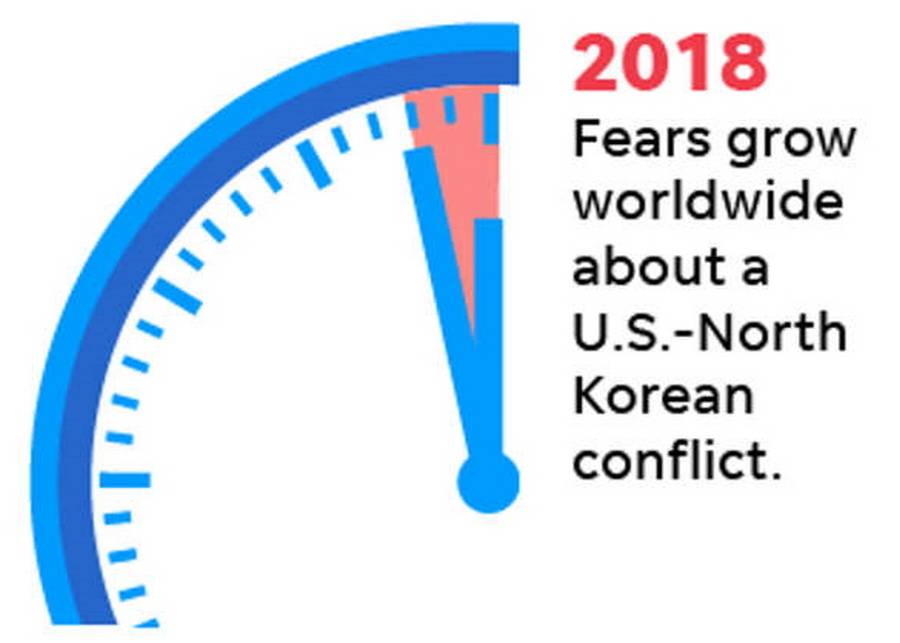ARMs1 for the Rest of Us2 3
Humanity today possesses powers beyond the wildest dreams of our ancestors. But this contrasts sharply with personal powerlessness, strangely, even collectively.
From any historical vantage point, the powers that humanity has acquired in the past few generations are mind-boggling. For humanity’s first 100,000 generations, most people had to toil most waking hours to try to secure food and shelter; and despite these toils, a vast array of plagues, pestilence, predation and other calamities would prematurely extinguish life as a matter of course.4
Today, however:
- A single US farmer can feed 175 people5, a number that rises every year. Worldwide the system feeds eight (8) billion (a number that also rises every year) a diet rich in protein and calories.
- Modern medicine controls communicable disease that would routinely decimate populations; saves life and limb in the aftermath of wounds that once meant amputation or death; and staves off an ever-increasing array of formerly fatal conditions.
- Shelter for average people has never been so secure (or comfortable). People are less likely than ever to suffer physical violence.6
For the first time in history of life on earth, one species, Homo sapiens, is winning not only battles against the four horsemen of biblical Revelations, but perhaps even the war.
7 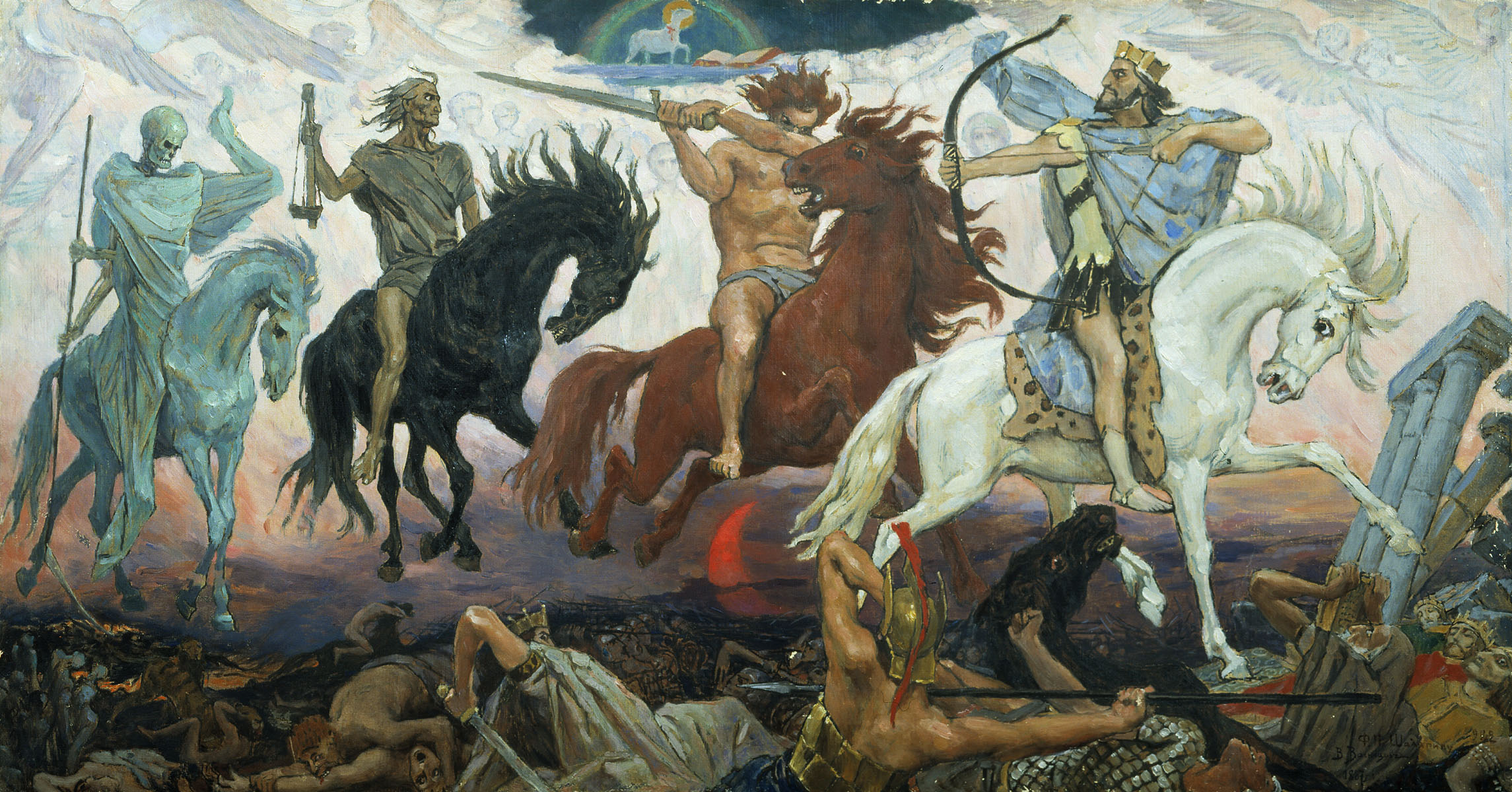 |
|
|
A transformation in the history of life: Humanity is no longer powerless against the four horsemen of biblical Revelations. Yet Doomsday has never been nearer. |
|
A Paradox of Power and Powerlessness
These powers, however, mask a simultaneous powerlessness. This is plain with respect to weaponry. War currently kills fewer than ever, but that can change in a flash—literally. Prior to World War I, soldiers could kill a single person at a time; thirty years later, a single bomb, “Little Boy,” razed Hiroshima and in a flash killed 80,000 people.8. By the time Neil Armstrong took his giant leap for mankind, humanity had also leapt into a theoretical self-annihilation era.9 Although this leap looms less large than it once had, rulers of a growing number of nations10 now can annihilate humanity and most other life on the planet in any of a growing number of ways.11 These threats are collectively so substantial that in 2018 the Doomsday Clock Science and Security Board advanced its iconic clock to two minutes till midnight, equaling the most perilous rating it has ever issued.12
Powerful weapons also now provide any one person the ability to efficiently liquidate large assemblages or any powerful entity to discretely liquidate any one person. Statistically speaking, we may on average be safer than ever, but our safety is no longer in our hands. Neither strength nor skill nor conventional armaments provide protection against modern weaponry or institutional power; indeed, they may well provoke it.
As individuals, we’re as helpless against technology as our ancestors were against the forces of nature. Not just armaments, but almost every technological development. Consider fossil fuel extraction: energy companies shatter the earth13 and remove mountaintops14, using toxins by the ton.15 Or the massive transformations in information technology: increasingly “they” know more and more about you16—while you know less and less about “them,” (even who “they” are).17
 |
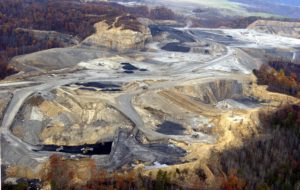 |
Mountaintop removal mining increases flooding, contaminates drinking water, and cracks building foundations. The accompanying blasting showers towns with dust, noise and occasionally deadly projectiles. Over 300,000 acres of Appalachian hardwood forests have already been bared and left barren.
Below left: A ‘Major Second Wave’ of U.S. fracking is about to be unleashed upon the world. Fracking effects include earthquakes and infrastructure degradation, severe air and groundwater contamination, and greenhouse gas release. Right: The 1.5 billion-dollar one million square-foot NSA Utah data center, the “ first facility in the world to gather and house a yottabyte“.
(Pictures and captions are inadequate to convey the scale and scope of these activities, but click on images to enlarge and see the annotations above for additional information.)
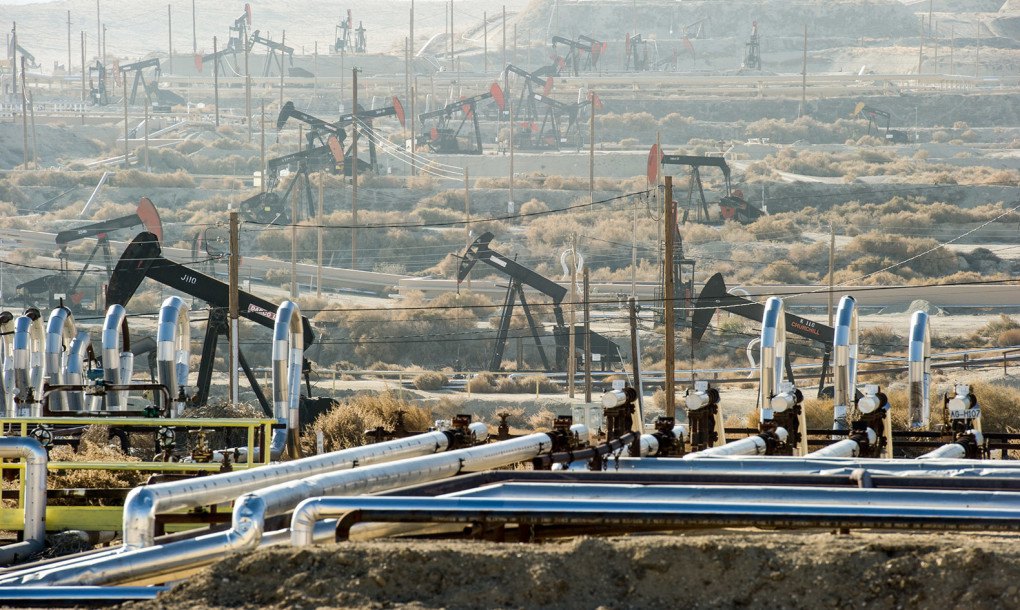 |
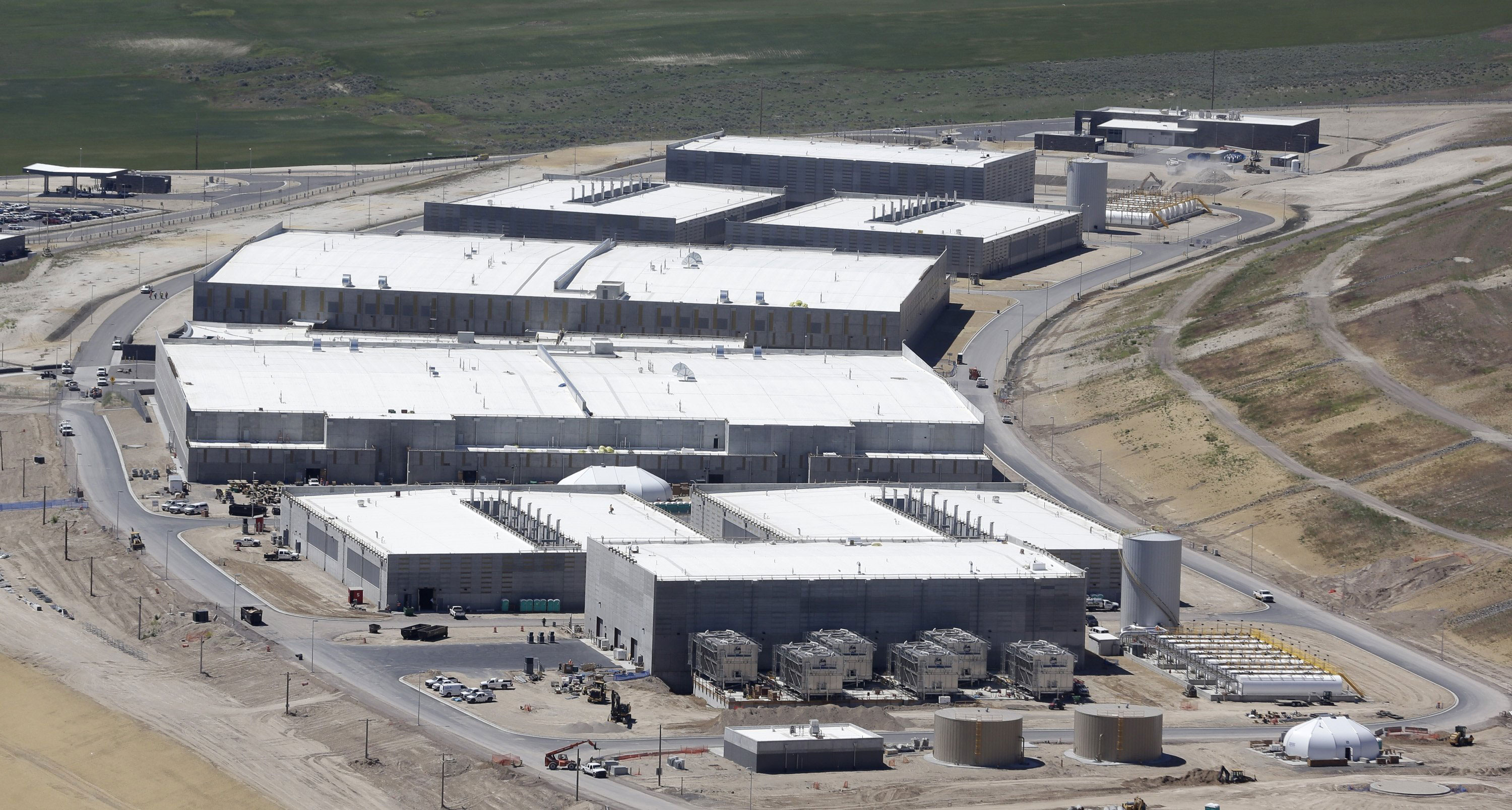 |
Paradoxically, we seem even collectively powerless regarding technology. For example, despite relentless labor saving technological innovations, organizations demanding ever more from those who remain—to the point of sickness, even death.18 Fifty years ago, vibrant labor unions across the globe would systematically engage in collective action to ensure a share of productivity gains, through better wages and benefits as well as dignity for workers. All that is an anachronism, almost erased from memory.19
The Turbine of Technology and Institutional Gains
For most of the two-and-a-half million years or so of human existence, the parameters of life did not change dramatically from generation to generation. With the rise and fall of knowledge over the past few millennia, civilization would lurch forward and slide back. But institutional application of science over the past few generations now drives relentless technological change — with compounding acceleration.20
Technological capability derives from capacity to acquire and apply scientific knowledge for practical purposes — in short, applied research methodologies, or ARMs as we’ll call them.
Such capacity, however, is narrowly concentrated. A few sectors function at the center of this complex: The US federal government alone funds close to $100 billion annually on military-related research.21 US “health-care” research expenditures coming both from and to a variety of sources including providers, insurers, pharmaceutical companies and the like may well top that.22 And the massive infrastructure and brain-power in schools of management and much of social science support the world’s dominant financial and industrial institutions.23 Not always directly – even management professors tend to skew left – but the critics too play a critical role (perhaps most important of all) in identifying vulnerabilities and shortcomings to manage as well as in advocating reforms to keep the system afloat.
Beyond this central complex, most successful firms in competitive markets employ research effectively in their core competency, e.g., energy companies know how to remove mountain tops or how to fracture the earth (and how to manipulate governments not only for statutory relief, but subsidies as well!); the rest of their operations, usually no. Even the most heavily ARMed institutions tend to falter on staff functions; few companies employ extant knowledge well, let alone produce knowledge to aid in functions such as human resource management.24
And then there is your organization … and you. If you’re outside the core operations of a core complex institution, it’s unlikely that management research and education address your needs. As, for example, when I found myself at the head of a non-profit organization: How to manage volunteers? How to cultivate relations with donors? Never in two decades of management research and education had these kinds of issues come up. The vast resources and brainpower of higher education focus, rather, on what’s of interest to the likes of Goldman Sachs and Google. Everyone else is playing keep up. And odds are long that you’re falling further and further behind.
Benefits and Consequences: Winners and Losers: Past, Present and Future
Most of us have on-the-whole benefited from most technological change, but the distribution of benefits has been unequal, and these inequalities may be poised to explode. Those who control the applications and algorithms are on the verge of (or already in possession of) godlike powers; those who know nothing about them except how to play a video game are on the verge of superfluity.25
Over the past two centuries, machinery has remarkably freed humanity from the consuming physical labors of life—and correspondingly eliminated a great swath of the labor market. Despite difficult transitions, many workers around the world who once might have done manual labor now do so-called knowledge work. Silicon, however, does cerebral even better than steel does cerebellious. Algorithms increasingly perform knowledge work cheaper and better than humans can—and correspondingly will eliminate an even greater swath of present jobs, including those of many highly-paid professionals (yes, yours too)!26
 |
 |
|
IBM’s Watson shown here easily defeating two all-time human Jeopardy champions is one of industry’s most widely deployed artificial intelligence agents. At the time, 2011, Watson required a room-sized computer; now a microprocessor can do the work.27 Right: IBM was recently indicted for purging older workers en masse.28 |
|
No one likes being exploited, but those perceived as useless may end up longing for it.
Technological Progress and Systems Pushed to the Brink
For all the wonders applied science has delivered, capacity for systemic improvement —or even sustainability—has languished. Consider two of applied science’s most remarkable contributions—the transformational advances with which we began this column: winning the war against famine and disease.
Industrial agriculture29 is winning the war against hunger (for the moment); and doing so with high animal-protein diets that require far more land, cultivation and energy than plant-based nutrition. But industrial agriculture has also brought soil depletion; destruction of fresh water systems; oceanic dead zones; and a living death march through hell for the condemned chickens, calves, pigs and fish. This system plays a significant role in global warming30; the biotic crisis31; and, ironically, epidemics of obesity32 and other diseases of overindulgence, which now account globally for three times as many deaths as malnutrition 33.
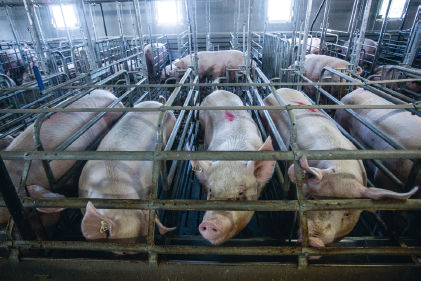 |
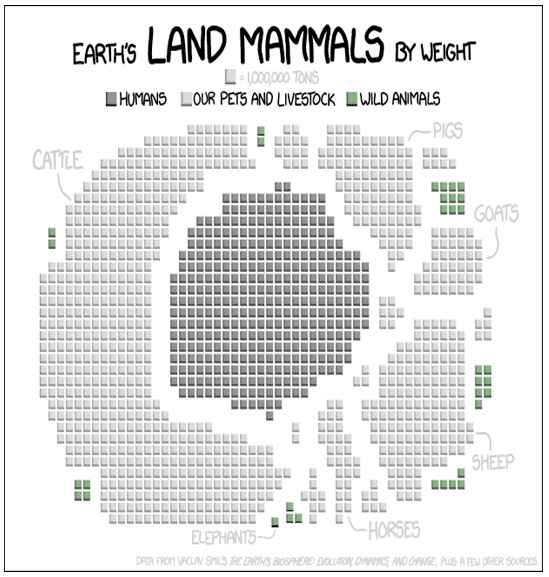 |
|
Life in the state of nature may sometimes be nasty, brutish and short, but at least it’s life. Historian/ futurist Yuval Harari on sows confined in gestation crates: “These highly social and intelligent beings spend most of their lives in this condition, as if they were already sausages.”34 |
Humans, the animals we eat and pets we keep now account for more than 90% of all large land mammals.35 |
Modern medicine extends lives, but often without regard to quality or meaning of life. Even children are now overweight and heavily medicated. In the middle we suffer from an array of diseases and addictions unknown in pre-industrial eras.36 At end, nursing home and hospital protocols keep increasingly incapacitated “patients” nominally alive, without regard to what’s actually important to all involved.37 It’s a train wreck of a system, now approaching 20% of GDP in the US—a system so bloated, inefficient, and wasteful that even the most avaricious insurance company investor can barely abide.38
Traditional science, including traditional ARMs, achieves its success by narrowing a problem, isolating two variables and measuring the impact of one upon the other. Spurred by its success, the formula, one problem=one solution, drives most modern thought and action. But life of course is inextricably interconnected and complex. Imposing solutions without appreciating systemic considerations inevitably spawns “unanticipated consequences” that are often far more consequential than the ostensible main effect.39
Where we’re at: (people in general)
Despite advances in science and technology, we remain today much like early hominids at the mercy of a fearsome, poorly understood array of threats. But whereas our ancestors were humbled by forces of nature, we face faceless institutional forces that (for the moment) have the upper hand even on nature.
Much like the gods of antiquity, these heavily ARMed institutions operate on an Olympian plane, their human proxies battling in corporate, political and military war rooms, the rest of us relegated to the sidelines
In Ancient Rome, long after republican principles were overwhelmed by oligarchic and imperial interests, plutocrats and high officials would regularly stage games with gladiator battles, spectacular damnatio ad bestias and re-enactments of foundation myths. Classical historian Mary Beard explains, “people were watching myth re-enacted in a way that was vivid, in your face and terribly affecting. This was theater, cinema, illusion and reality, all bound into one.”40
 |
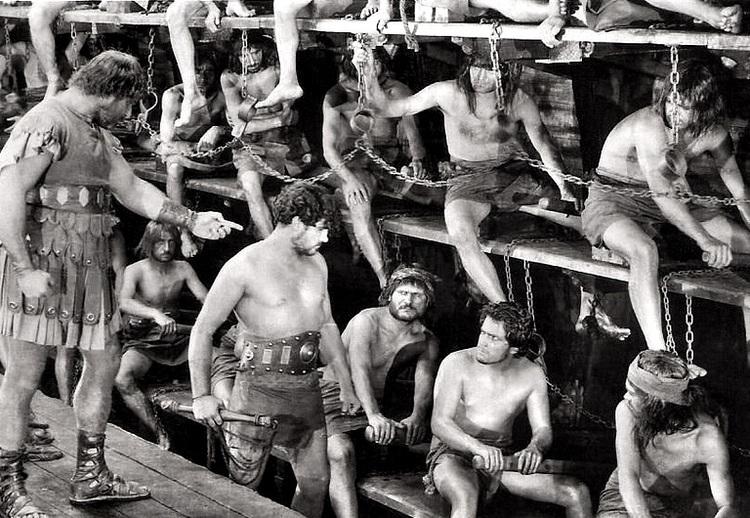 |
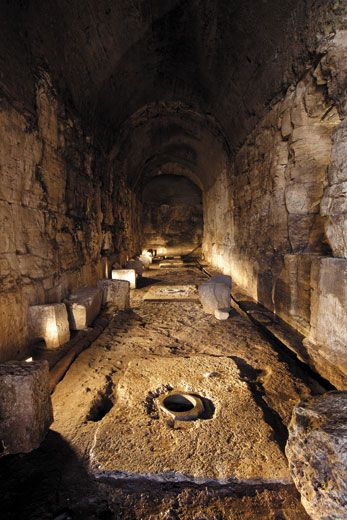 |
Left: The Roman Colosseum: A theater of blood lust. Center: According to our tour guide, slaves were chained and many never saw the light of day (as depicted in Ben Hur 1925); working deep in the stadium’s bowels, they pushed vertical winches (right) to propel elevators that carried animal cages up to the arena.
Today, we’re likewise treated to endless games, theater, cinema and illusion, though it all may pale in comparison to the vivid brutality experienced by Roman citizens live in the grandeur of the Colosseum. Our virtual experience may be more comparable to that of the slaves locked deep in the stadium’s bowels41, only seeing shadows and hearing echoes of the spectacle.
Where we’re aiming: (You and I)
This column and the intellectual program from which it emerges is a way out of the labyrinthian entrails, maybe even a way to peel ourselves free from the spectacle and its effects—to remedy ignorance, blind techno-determinism, and powerlessness. In short, we aim to:
1. Broaden the benefits conferred from science and its applications, i.e., extend them to you!
2. Broaden understanding of research application, i.e., to consider problems systemically, minding the larger purposes we hope to achieve.
3. Broaden the benefits also to us collectively; if enough of us can understand science, application and systems thinking … who knows?
Goal #1 is the idea behind a professional research doctoral program. I’ll try to convey here the material as best as possible within the limits of mass communication.
Goal #2 is the intellectual motivation unique to our professional research doctorate. I’ll also try to convey some of the ideas of systems thinking here, especially as they pertain to research methods.
Goal #3 is the motivation behind this column. Only a small number of students can matriculate into ours or any doctoral program, but real world systemic change requires that many of the rest of you understand science and systems: My hope here is to provide the insights and tools that enable you to see through and cast aside charlatanry that parades as fact and wisdom, to end reliance upon purported authoritative expertise, and provide instead the tools for intellectual self-reliance, to be able to cull extant knowledge and avail yourself of it, to identify what you need to know and then be able to come to know it.
All three goals begin with understanding ARMs and developing the skills to use them.42
References
Adams, Stephen (2012-12-13) “Obesity killing three times as many as malnutrition” The Telegraph (UK) https://www.telegraph.co.uk/news/health/news/9742960/Obesity-killing-three-times-as-many-as-malnutrition.htmlAtomic Heritage Foundation (2014) “Bombings of Hiroshima and Nagasaki – 1945” https://www.atomicheritage.org/history/bombings-hiroshima-and-nagasaki-1945
Ben Hur (1925) Metro-Goldwyn-Mayer Corp. Producers: Louis B. Mayer, Samuel Goldwyn, Irving Thalberg https://catalog.afi.com/Catalog/moviedetails/2811
Burns, Jack (2018) “California Found to Be Harvesting Newborn DNA For Decades Without Parental Consent” Free Thought Project, June 10, 2018, https://thefreethoughtproject.com/california-found-harvesting-newborn-dna-without-parental-consent/
Cooper, Dave (2018) The Mountaintop Removal Road Show. http://www.mountainroadshow.com/
Del Monte, Louis A. (2017) Nanoweapons: A Growing Threat to Humanity. U of Nebraska Press.
Drum, Kevin (2017-11) “You Will Lose Your Job to a Robot—and Sooner Than You Think” Mother Jones
Dupuy, T.N. (1979) Numbers. Predictions and War: Using History to Evaluate Combat Factors and Predict the Outcome of Battles. The Bobbs-Merrill Company, Indianapolis/New York.
Gawande, Atul (2014) Being mortal: medicine and what matters in the end. Metropolitan Books.
Gilbert, Natasha (2012-10-31) “One-third of our greenhouse gas emissions come from agriculture.” Nature News https://www.nature.com/news/one-third-of-our-greenhouse-gas-emissions-come-from-agriculture-1.11708
Gosselin, Peter and Ariana Tobin (2018-03-22) Inside IBM’s Purge of Thousands of Workers Who Have One Thing in Common” Mother Jones in partnership with ProPublica.
Harari, Yuval Noah (2016) Homo Deus: A brief history of tomorrow. Random House.
Hoffman, Joe (2018-03-05) Potential Health and Environmental Effects of Hydrofracking in the Williston Basin, Montana Geology and Human Health https://serc.carleton.edu/67733
Johnston, Ian (2017-08-26) “Industrial farming is driving the sixth mass extinction of life on Earth, says leading academic” The Independent Online. https://www.independent.co.uk/environment/mass-extinction-life-on-earth-farming-industrial-agriculture-professor-raj-patel-a7914616.html
Kinealy, Christine (1994) This Great Calamity. Gill & Macmillan, ISBN 0-7171-1881-9
Landesman, Peter (2002-03) “A Modest Proposal From the Brigadier: What one prominent Pakistani thinks his country should do with its atomic weapons” The Atlantic Monthly http://www.theatlantic.com/issues/2002/03/landesman.htm
Lemarchand, G. A. (2009) “The Lifetime of Technological Civilizations and their Impact on the Search Strategies.” Bioastronomy 2007: Molecules, Microbes and Extraterrestrial Life. Vol. 420.
Lim, Stephen S., et al. (2012) “A comparative risk assessment of burden of disease and injury attributable to 67 risk factors and risk factor clusters in 21 regions, 1990–2010: a systematic analysis for the Global Burden of Disease Study 2010.” The Lancet 380.9859: 2224-2260
Littleton, Cynthia (2016-06-25) “Oliver Stone Talks ‘Snowden’ Financing Struggle, Film vs. TV and Military ‘Adulation’ in Movies” Variety http://variety.com/2016/film/news/oliver-stone-snowden-tv-conan-the-barbarian-midnight-express-1201803664/
Malik, John (1985-09) “The Yields of the Hiroshima and Nagasaki Nuclear Explosions” Los Alamos National Laboratory 8819: http://large.stanford.edu/courses/2018/ph241/furrer2/docs/la-8819.pdf
Mecklin, John, and the Bulletin of the Atomic Scientists Science and Security Board (2018) “It is now two minutes to midnight: 2018 Doomsday Clock Statement” https://thebulletin.org/2018-doomsday-clock-statement
Mirani, Leo (2015-01-15) “Humanity keeps discovering brilliant new ways to destroy itself” Quartz. https://qz.com/326517/humanity-keeps-discovering-brilliant-new-ways-to-destroy-itself/
Mueller, Tom (2011-01) Secrets of the Colosseum: A German archaeologist has finally deciphered the Roman amphitheater’s amazing underground labyrinth. Smithsonian Magazine https://www.smithsonianmag.com/history/secrets-of-the-colosseum-75827047/
Munroe, Randall (2014-03-05) “Large mammals” xkcd https://xkcd.com/1338/
Ng, Marie, et al (2014) “Global, regional, and national prevalence of overweight and obesity in children and adults 1980-2013: a systematic analysis for the Global Burden of Disease Study” The lancet 384.9945: 766-781.
Pecchi, Lorenzo and Gustavo Piga, eds (2008) Revisiting Keynes. MIT Press
Pfeffer, Jeffrey (2018) Dying for a Paycheck: Why the American Way of Business Is Injurious to People and Companies. New York: HarperCollins. ISBN 9780062800923. OCLC 1017972923
Pinker, Steven (2011) The Better Angels of Our Nature. Viking
Ridlington, Elizabeth, and John Rumpler (2013-10) “Fracking by the Numbers: Key Impacts of Dirty Drilling at the State and National Level” Environment America. https://environmentmaryland.org/sites/environment/files/reports/MD_FrackingNumbers_print.pdf
Roeder, Oliver (2018-01-03) Chess’s New Best Player Is a Fearless, Swashbuckling Algorithm https://fivethirtyeight.com/features/chesss-new-best-player-is-a-fearless-swashbuckling-algorithm/
Roser, Max C. (2018) The Visual History of Decreasing War and Violence: A short presentation about the rise of political freedom and decline in violent deaths.) accessed June 21, 2018. Our World in Data https://ourworldindata.org/slides/war-and-violence/
Samsara (2011) Magidson films. Producer: Mark Magidson. Director: Ron Fricke. Food sequence: https://www.youtube.com/watch?v=k56NBsZXjr8
Soraghan, Mike (2015-08-18) “The fracking ‘loophole’ that just keeps growing.” Energy & Environment News https://www.eenews.net/stories/1060023558
Snowden (2016) Director: Oliver Stone. Endgame Entertainment, Vendian Entertainment, KrautPack Entertainment43 https://www.snowdenfilm.com/
Sullivan, Alison (2014) Gazette http://www.thegazette.com/subject/news/government/fact-check/fact-check-reynolds-says-one-iowa-farmer-feeds-155-people-worldwide-20140524/ (sourced from U.S. Farms and Farmers 2012 Census of Agriculture report highlights: http://www.agcensus.usda.gov/Publications/2012/Preliminary_Report/Highlights.pdf)
Trimarchi, Maria (2014-10-26) “How many people does one farmer feed in a year?” HowStuffWorks accessed 23 June 2018
Vandermeer, John, et al. (2009) “Effects of industrial agriculture on global warming and the potential of small-scale agroecological techniques to reverse those effects.” La Via Campesina
Ward, Ken Jr. (2017) “Another study confirms mountaintop removal’s impacts on Appalachian water quality” Charleston Gazette-Mail, July 14, 2017 http://blogs.wvgazettemail.com/coaltattoo/2017/07/14/another-study-confirms-mountaintop-removals-impacts-on-appalachian-water-quality/
Warner, Barbara, and Jennifer Shapiro (2013) “Fractured, fragmented federalism: A study in fracking regulatory policy.” Publius: The Journal of Federalism 43.3: 474-496.
Worland, Justin (2018-03-06) “A ‘Major Second Wave’ of U.S. Fracking Is About to Be Unleashed Upon the World.” TIME. http://time.com/5187074/fracking-energy-oil-natural-gas/
Yao, Mariya (2017-03-05) 10 Major Brands Using IBM Watson https://www.topbots.com/10-major-fortune-500-brands-using-ibm-watson/
Notes
- Applied Research Methodologies
- About this article: I am using an experimental style to try to several conflicting aims: significance, rigor, documentation, ease of reading, and concision (see style notes).
- I’m grateful to Luke Swinson for help writing this article; and Joseph Sweeney, Josh Mitteldorf, Eugene Louis de Klerk, Aurora Casta and Larry Starr for feedback on an earlier draft.
- At nearly all times for nearly all living things, life on earth is foremost a struggle for survival; for the moment at least, most of humanity has, largely escaped Darwinian existential reality. the primary preoccupations that have characterized life for time immemorial – hunger, disease and predation – are, for most of us, no longer primary, ever-present threats.
Consider the first and foremost preoccupation of life – calories. In the developed world, starvation has largely been eliminated; even the poorest people on the planet rarely starve to death and if they do, it emanates from war rather than insufficient food supply. Today in Europe, as in North America, diseases of over-eating are more than 10 times greater than malnutrition (Lim, et al 2012) – which itself is a long way from starvation. But until 100 years ago, day-to-day sustenance was the basic preoccupation of life, and whether you’d have enough to eat was never a given. Large portions of the population would periodically starve to death: for example, Finland 1696–97 (~33%), East Prussia 1708–11 (~41%); Ireland 1740–41 (~33%) and again in “the Great Famine” (1845-1849) ~13% died and another 13% emigrated under starving conditions to America. 10% of France may have starved to death in each of 14 famines between 1696 and 1778; Austrian Galicia (present day Poland, Ukraine) suffered a series of 14 famines in between 1804 and 1913.
Globally, the situation has been even worse and continued longer, right up until the Green Revolution of the 1960s. In China, 1,828 major famines were recorded between 108 BC and 1911 AD, or one nearly every year. In four years of these years – 1810, 1811, 1846, 1849– a total of 45,000,000 cumulatively perished. Another 60,000,000 perished during droughts from 1850-1873. More recently, 15 million perished starved during Mao’s Great Leap Forward. In South Asia, 10,000,000 (~33% of the local population) died during the Great Bengal famine of 1770. Etc.…, etc.….
Famine Sources: Wikipedia “list of famines” and “famines in China,” both accessed 6/16/18; “Great Famine” Kinealy (1994). - Sullivan (2014). Also see Trimarchi (2014): US farmers in 2000 produced on average 12 times as much output as a farmer did in 1950.
- “News,” entertainment and standard political fearmongering suggest the world is a very dangerous place. Well, certainly not by historical standards: across the globe, people in 2018 are far less likely to suffer injury or death from violence than at any time in recorded history, a steady downward trend that precedes even the world wars (Pinker 2011; Roser 2018).
- “Four Horsemen of Apocalypse” Painted by Viktor Vasnetsov in 1887. Via Wikimedia Commons
- All told about three-quarters of Hiroshima’s 300,000 residents would perish, most of the rest from burns and radiation poisoning. (Atomic Heritage Foundation 2014)
- Dupuy (1979) developed a Theoretical Lethality Index for weapons to identify their killing capacity. Lemarchand (2009) used his tools and measures to graph “advances” in theoretical lethality over time.
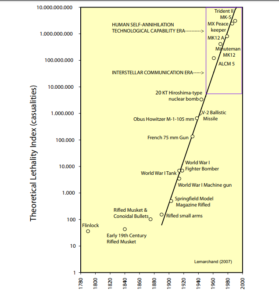 (click to enlarge the image). Note that we entered the Theoretical Lethality Era not in 1945 or even 1953 because early nuclear weapons, even the fearsome Hydrogen Bomb, could only blow a small portion of the globe into oblivion. It wasn’t until the 1960s that any one power (i.e., the US) accumulated sufficient nuclear weaponry to annihilate humanity
(click to enlarge the image). Note that we entered the Theoretical Lethality Era not in 1945 or even 1953 because early nuclear weapons, even the fearsome Hydrogen Bomb, could only blow a small portion of the globe into oblivion. It wasn’t until the 1960s that any one power (i.e., the US) accumulated sufficient nuclear weaponry to annihilate humanity - In the center of every major city in Pakistan, one of about a dozen Club Nuclear nations, sits a replica of the mountain home of Pakistan’s nuclear test site commemorating the “Islamic Bomb.”
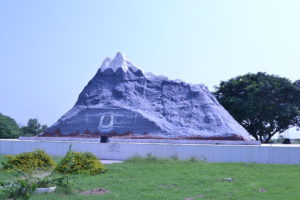 (click to enlarge the image). See Landesman (2002) for an account of its veneration and the sincere hope expressed by one prominent Pakistani that his country use it.
(click to enlarge the image). See Landesman (2002) for an account of its veneration and the sincere hope expressed by one prominent Pakistani that his country use it. - Nuclear weaponry is only one of an ever-increasing number of brilliant new ways humanity keeps discovering to destroy itself (Mirani 2015). A partial list of extinction threats aside from that posed by nuclear arsenals includes climate change, biological warfare, cyberwar, synthetic biology that could destroy food chains or create new pandemics and artificial intelligence through any number of paths, e.g., lethal autonomous weapons (or “killer robots”). Indeed, it’s hard to keep up with all the ways apocalypse may befall. Del Monte (2017), for example, claims that Nano-weapons may soon render humanity extinct.
- The Doomsday Clock Science and Security Board’s assessment (Mecklin, et al 2018) that we are now at two minutes till midnight, i.e., on the verge of annihilation, is matched only by the 1953 issuance in the wake of Hydrogen Bomb development.
- Fracking literally shatters the earth, causing earthquakes and infrastructure degradation. Other eco-effects include groundwater contamination, air pollution, methane pollution, leading to human illness, animal deaths and climate change. Massive quantities of water consumption lead to depleted supplies. Some sources include Hoffman (2018), Ridlington & Rumpler (2013). More at: Crisis Preparedness and Organizational Resilience: Fracking. Now a “‘Major Second Wave’ of U.S. Fracking Is About to Be Unleashed Upon the World (Worland 2018)
- Mountaintop removal: q.v., Ward (2017), Cooper (2018). See also powerful imagery on Willie Nelson’s 2014 music video, America The Beautiful?
- Warner (2013): “Unlike the regulation of other heavy industries, fracking has been exempted from federal reach, leaving regulation to the states, which appear vulnerable to capture by energy interests.”
• The U.S. Energy Policy Act of 2005 included a provision widely derided as the “Halliburton Loophole,” explicitly exempting fracking operations from key provisions of the Safe Drinking Water Act.
• Fracking waste is exempted from regulation of hazardous waste under the Resource Conservation and Recovery Act (RCRA) of 1976, even though some toxic components of fracking would normally fall under RCRA’s strict requirements
• Fracking waste is exempted from disclosure requirements under the federal Emergency Planning and Community Right to Know Act. The act requires companies to submit annual Toxic Chemical Release Forms reporting their use of toxic chemicals to the U.S. Environmental Protection Agency (Fracking industries claim that some of the chemicals they use are proprietary and that their disclosure would harm their competitiveness).
• Neither the federal Clean Water Act dealing with disposal issues, nor the Hazardous Materials Transportation Act covering transport of hazardous chemicals, regulates key components of fracking.
See also Soraghan (2015) - Remember Edward Snowden? The spying scandal exposed by the high-level programmer revealed that U.S. National Security Agency (NSA) had:
• Collected and stored phone records of all the tens of millions Verizon customers on an “ongoing daily basis”
• Tapped directly into the servers of nine internet firms, including Facebook, Google, Microsoft and Yahoo, to track online communication in a surveillance program (Prism)
• With the UK’s Government Communications Headquarters (GCHQ), tapped into 200 fiber-optic cables allowing it to monitor up to 600 million international communications every day
• Collected and stored almost 200 million text messages per day across the globe
• A “black budget” for secret operations of $53 billion in 2013 (this is in addition to its massive on-the-books appropriation!)
An easy, excellent introduction to the modern NSA is Oliver Stone’s Snowden (2016), an extraordinary film, both as entertainment and exposé.
Another way in which “they” know more about you than you probably ever imagined: “California Found to Be Harvesting Newborn DNA For Decades Without Parental Consent” (Burns 2018) - Please suggest in the comments any thoughts about technological developments fundamentally changing the balance of power between institutions and individuals and other relevant examples.
- q.v. Pfeffer (2018)
- There are actually several paradoxes here:
(1) Humanity is no longer powerless against plagues, pestilence, predation, etc… yet Doomsday has never been closer; that humanity has these formerly unfathomable powers, but individuals are perhaps less in control of their destiny than ever.
(2) Even collectively people don’t have much power, which is a paradox because how can it be that “humanity” has power if people – even collectively! – do not? What is humanity if not people – even collectively?
An earlier draft was probably better, or at least more clear, because I drew on some examples, but because they were political, I didn’t want to include them. It’s difficult now to even mention names, “Trump,” “Obama” or most any world leader really, without seriously turning some people off. And I didn’t want to do that, and certainly not in a first piece. If you’re interested, let me know. Perhaps we’ll take it up in a future piece.
(3) Then there is the example that I do use, that despite relentless labor saving technological innovations, people are working if not harder than ever, certainly much harder than 50 years ago. As a boy, my father easily supported a family of 5 on a HS equivalency degree technician’s salary. He also had time to coach our little league teams, take us on trips almost every weekend; and start a business on the side. Try doing any of that now! - Perhaps I draw a timeline in a future piece: the history of civilization is less than ½ of 1% of human history, and the history of science only a small fraction of that. And then it’s application only a fraction of that. But maybe someone has already done this?
- A principle function of engineering research resources at leading institutions is to provide weapons that make the glitziest gadget of James Bond and his progeny look like primitive flints in comparison.
- In return they get the income that flows from the miracles of modern medicine, as well as the increasingly irreplicable findings that nevertheless justify ever more expenditures. A privileged few are also anticipating the realization of significantly extended lifetimes.
- The relationships goes well beyond direct funding. For example, Penn’s Wharton School is now a worldwide behemoth with an annual budget exceeding $500 million. Financial institutions support some research directly – but principally they support 500 faculty members with lavish facilities and opportunities, including scandalously high paying consultancies, speaking fees, board positions, etc… Students are inspired to dole out hundreds of thousands in tuition and several prime young years of life in the expectation of positive ROI.
- I’d like to do some piece on people analytics and workspace issues soon, as well as perhaps a case study on how retrograde some units are of major companies and institutions. Perhaps also a piece on how poorly management works at leading schools of management and how poor the operations can function at leading technological institutes.
- For further reading, see Homo Deus: A Brief History of Tomorrow (Harari 2016), an illuminating, provocative and engaging book on the subject. Harari examines how we might expect new godlike technologies, such as artificial intelligence and genetic engineering, to impact the world.
- (Drum 2017)
- Watson: Yao (2017). Increasingly, machines don’t even need human programmers to learn. Self-taught computers can outperform those programmed to take advantage of the history of human learning after only a few hours of experimentation (Drum 2017; Roeder 2018)
- Gosselin (2018)
- For a striking six-minute industrial agriculture montage, see this sequence from the film Samsara (2011): https://www.youtube.com/watch?v=k56NBsZXjr8
- Gilbert (2012): One-third of our greenhouse gas emissions come from agriculture. Vandermeer (2009): Overwhelmingly, these emissions come from industrial agriculture rather than traditional or alternative agroecological techniques.
- Johnston (2017): Industrial farming is driving the sixth mass extinction of life on Earth.
Munroe (2014): Humans, the animals we eat and pets we keep now account for more than 90% of all large land mammal biomass. - You may have seen this two-minute video showing just how fast the US got very fat: US Obesity Epidemic, 1985-2010, https://www.youtube.com/watch?v=uH0tWM4H0h8, a brief year by year map sequence showing the dramatic increase in obesity rates across America from 1985 to 2010 based on statistics from the US Centers for Disease Control and Prevention. The trend has not abated. And it’s not just America anymore. Much of the rest of the world has gotten even fatter even faster. A massive study produced by more than 100 scientists (Ng, et al. 2014) published in The Lancet shows that as of 2013 many countries throughout the world are now even more overweight than the US. More than half of adults were overweight in more than half of all countries. More than 75% were overweight in many, including most Middle Eastern nations and island nations globally. Strikingly, more than half of women over 20 were obese in Qatar, Kiribati, Libya, Micronesia and Kuwait. In Tonga and Samoa, more than two-thirds were.
- (Adams 2012)
- Harari (2016) Chapter 2 The Anthropocene, page 71
- Munroe (2014)
- Per the “Global Burden of Disease Study” (Lim, et al. 2012) published in a special edition of The Lancet: Between 1990 and 2010 overall global life expectancy at birth rose by about five years. But people are spending more of their years in poor health, due largely to increases in diseases linked to obesity, including type II diabetes, heart disease and cancer.
- Gawande (2014)
- Years ago, maybe as (the U.S.) Congress was debating Obamacare, I read an op-ed essay (“My View” or something like that) in a newsmagazine (probably TIME or Newsweek) written by a health insurance company that I’ve been unable to track down. He lamented the toxic effect of government interference in the market and how people didn’t understand insurance (e.g., how his massage therapist wanted massages covered). Even he, having become phenomenally rich from the system—and most undeservedly so!—pointedly criticized the system as an abomination.
- I put “unanticipated consequences” in parentheses because these systemic impacts are referred to euphemistically as “unanticipated” or unintended”, they usually are anticipatable. For example, “side effects” of fracking include groundwater contamination, air pollution, impact of Methane on climate change, exposure to toxic chemicals, blowouts due to gas explosion, waste disposal issues, massive freshwater use (lowering water tables), earthquakes, workplace safety and infrastructure degradation. (Hoffman 2018)
Institutions develop technology for their commercial benefit, but introduce them for how they will help or even save mankind and ignore or try to cover up collective costs and detriments. The HBO comedy, Silicon Valley, regularly lampoons these would-be tech billionaire pronouncements of “trying to make the world a better place.”
I may do a column specifically on “unanticipated consequences.” An interesting prediction with respect to several points in this article were the long held, and often continuing, certainty of economists’ expectations of automation leading to unprecedented leisure, e.g., Economist John Maynard Keynes 15-hour working week (Pecchi and Piga 2008).
Ironically, weapons of mass destruction (WMDs) correlate with perhaps the most beneficial societal development of all. Despite periodic regional conflagrations and international stand-offs, the past 70 years represent an historically unprecedented period of world peace. People in 2018 are less likely to suffer injury or death from violence than at any time in recorded history, a steady downward trend that precedes even the world wars (Pinker 2011; Roser 2018).
In short, lacking a systemic perspective, systemic costs (and benefits) are almost totally decoupled from institutional objectives and the propaganda with which they are introduced.
- Mueller (2011)
- In 2010, the Roman Colosseum’s vast underground labyrinth was opened to the public after a major renovation. To me, this hypogeum was even more impressive than the Colosseum itself. According to our guide, slaves could spend their entire lives there, never seeing the light of day. Per German archaeologist Heinz-Jürgen Beste: “It was as hot as a boiler room in the summer, humid and cold in winter, and filled all year round with strong smells, from the smoke, the sweating workmen packed in the narrow corridors, the reek of the wild animals… The noise was overwhelming—creaking machinery, people shouting and animals growling, the signals made by organs, horns or drums to coordinate the complex series of tasks people had to carry out, and, of course, the din of the fighting going on just overhead, with the roaring crowd.” (Mueller 2011)
- Please weigh in on your recommendations or requests for future articles in the comments section!
- The film ultimately had to be made in Europe with financing from German and French production companies. See Littleton (2016) for the many obstacles and difficulties, Stone faced in making this film.
